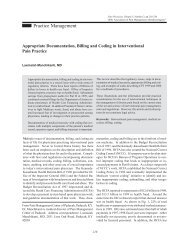ASIPP Practice Guidelines - Pain Physician
ASIPP Practice Guidelines - Pain Physician
ASIPP Practice Guidelines - Pain Physician
Create successful ePaper yourself
Turn your PDF publications into a flip-book with our unique Google optimized e-Paper software.
Manchikanti et al • <strong>ASIPP</strong> <strong>Practice</strong> <strong>Guidelines</strong><br />
74<br />
shown in Fig. 5.<br />
Thus, determining whether a service is worthwhile involves<br />
a number of different issues. It involves not only knowing<br />
whether the various components of the intervention are<br />
effective, but also how much they cost and if the delivery<br />
system is efficient. The preceding discussion concentrated<br />
on trying to determine whether interventional techniques<br />
in managing chronic pain could be shown to be effective<br />
through a systematic review. To achieve this goal, numerous<br />
relevant studies and reviews were reviewed for the<br />
quality and application to the subject of interventional techniques<br />
in chronic pain. Finally, the relative efficiency and<br />
safety of the possible interventions, and then the cost, have<br />
to be the key determinants. Table 16 shows various interventional<br />
techniques in managing chronic pain classified<br />
by evidence of effectiveness, as well as risk of side effects<br />
and cost of the procedure.<br />
CONCLUSION<br />
The practice guidelines for interventional techniques in the<br />
management of chronic pain were developed utilizing the<br />
best available evidence combined with consensus. These<br />
guidelines include discussions of the purpose, rationale,<br />
and importance. The guidelines also have discussed the<br />
importance of randomized controlled trials, the development<br />
of type and strength of efficacy evidence and various<br />
controversial aspects relating to guidelines. Chronic pain<br />
and its epidemiology, as well as discussion of chronic pain<br />
vs chronic pain syndrome, the pathophysiologic basis of<br />
persistent pain, and the evaluation of the patient presenting<br />
with chronic pain, have been discussed. Diagnostic<br />
and therapeutic interventional techniques are discussed<br />
extensively including all types of evidence available from<br />
randomized clinical trials as well as some observational<br />
studies. The levels of effectiveness for the most commonly<br />
used interventions were developed based on review of diagnostic<br />
and therapeutic interventional techniques. Additionally,<br />
effectiveness evidence and an algorithmic approach<br />
to managing a patient presenting with chronic spinal<br />
pain were also developed.<br />
ACKNOWLEDGMENTS<br />
We would like to thank Bert Fellows, Denise Pratt, Tonie<br />
Hatton, Vidyasagar Pampati, and many of the members of<br />
the organization who have assisted in the preparation of<br />
this manuscript.<br />
REFERENCES<br />
1. Committee to Advise the Public Health Service on<br />
Clinical <strong>Practice</strong> <strong>Guidelines</strong>, Institute of Medicine.<br />
Field MJ, Lohr KN (eds). Clinical <strong>Practice</strong> <strong>Guidelines</strong>.<br />
Directions of a New Program. National Academy<br />
Press; Washington, 1990.<br />
2. Harris JS. Development, use, and evaluation of clinical<br />
practice guidelines. JOEM 1997; 39:23-34.<br />
3. McQuay H, Moore A. An evidence-based resource<br />
for pain relief. Oxford University Press. Oxford, New<br />
York, 1998.<br />
4. Woolf SH. <strong>Practice</strong> guidelines: A new reality in medicine.<br />
I. Recent developments. Arch Intern Med 1990;<br />
150:1811-1818.<br />
5. Woolf SH. <strong>Practice</strong> guidelines, a new reality. Medicine<br />
II. Methods of developing guidelines. Arch Intern<br />
Med 1992; 152:946-952.<br />
6. Turk MA. <strong>Practice</strong> guidelines. In Gonzalez EG,<br />
Materson RS (eds). The nonsurgical management of<br />
acute low back pain. Demos Vermande, New York,<br />
1997, pp 5-14.<br />
7. McQuay H, Moore A. Introduction: An evidencebased<br />
resource for pain relief. Oxford University Press,<br />
Oxford, New York, 1998, pp 1-4.<br />
8. Bombardier C, Esmail R, Nachemson AL et al. The<br />
Cochrane collaboration back review group for spinal<br />
disorders. Spine 1997; 22:837-840.<br />
9. Leape LL. <strong>Practice</strong> guidelines and standards: An overview.<br />
QRB Qual Rev Bull 1990; 16:42-49.<br />
10. Sackett D, Richardson WS, Roseberg W et al. Evidence<br />
based medicine. Churchill Livingstone, Philadelphia,<br />
1996.<br />
11. Tinker JH, Dull DL, Caplan RA. Role of monitoring<br />
devices in the prevention of anesthetic mishaps: A<br />
closed claim analysis. Anesthesiology 1989; 71:541-<br />
546.<br />
12. Shoemaker TS. <strong>Practice</strong> policies in anesthesia: A foretaste<br />
of practice in the twenty-first century. Anesth<br />
Analg 1995; 388-403.<br />
13. Shoemaker TS. <strong>Practice</strong> guidelines for pain management.<br />
In Ashburn MA and Rice LJ (eds), The Management<br />
of <strong>Pain</strong>. Churchill Livingstone. Philadelphia,<br />
1998, pp 205-226.<br />
14. Pierce EC. The development of anesthesia guidelines<br />
and standards. QRB Qual Rev Bull 1990; 16:61-64.<br />
15. McPherson K, Strong PM, Epstein A et al. Regional<br />
variations in the use of common surgical procedures:<br />
<strong>Pain</strong> <strong>Physician</strong> Vol. 4, No. 1, 2001
















